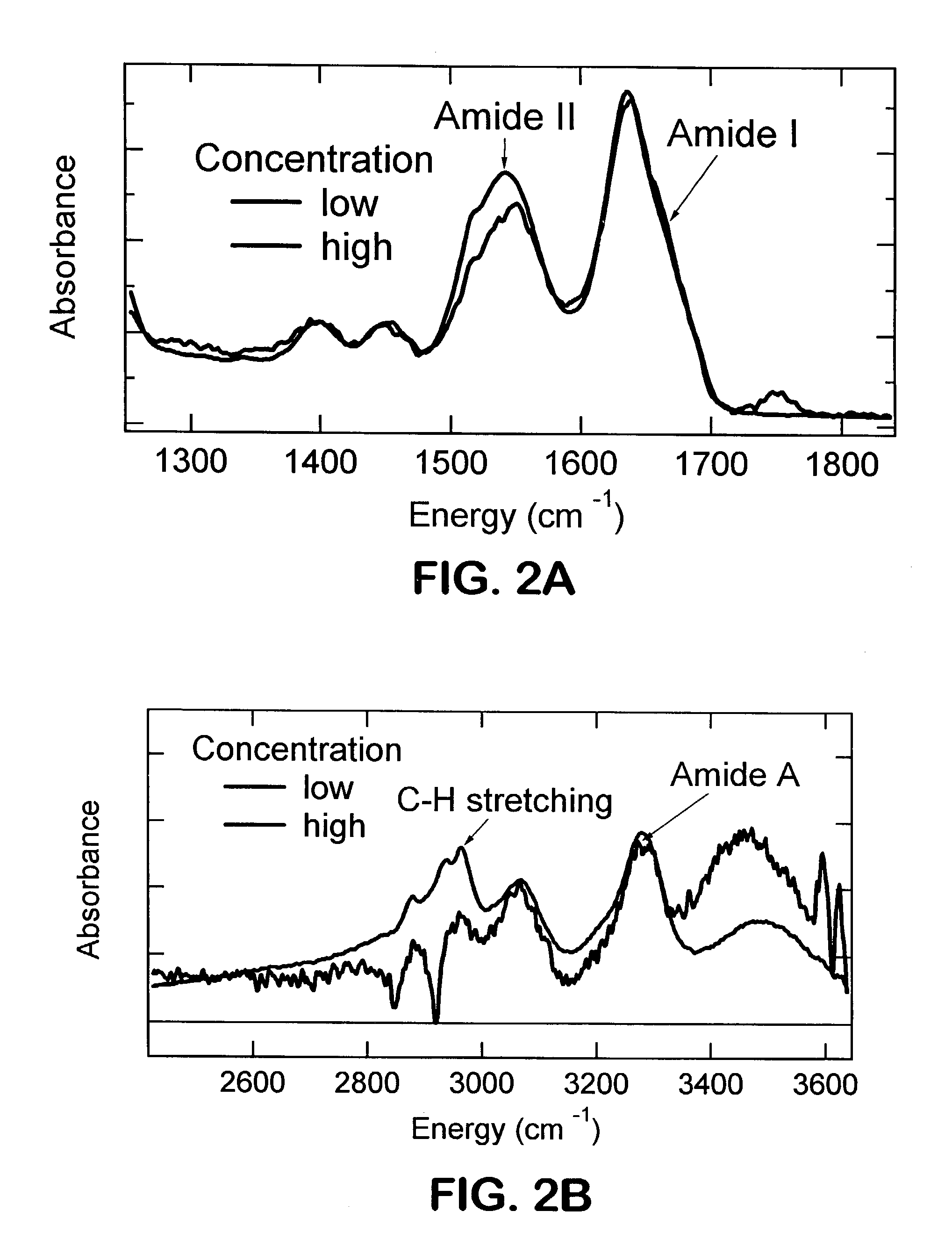Single pass attenuated total reflection fourier transform infrared microscopy apparatus and method for identifying protein secondary structure, surface charge and binding affinity
- Summary
- Abstract
- Description
- Claims
- Application Information
AI Technical Summary
Benefits of technology
Problems solved by technology
Method used
Image
Examples
example 1
IR Spectrum Acquisition
[0269]Mid-frequency and high-frequency ATR-FTIR spectra of a β-sheet forming protein were acquired as seen in FIGS. 2A and 2B. The spectral region shown includes both amide I with a peak at 1636 cm−1 and amide II with a peak at about 1550 cm−1, but also two other peaks at about 1400 and about 1450 cm−1, respectively. Discrepancies between the high and low concentration experiments are observed at about 1750 cm−1 and in the relative intensity of the amide II band. These could be attributable to the hydration state of the protein. In the high frequency region two germanium peaks appear in the low concentration spectrum (shown in blue) as negative spikes at about 2850 cm−1 and about 2910 cm−1. However, the same bands are clearly present in both low concentration and high concentration spectra. The Ge peaks can be removed by a background subtraction procedure.
example 2
Acquisition of IR Spectra from a Protein Having β-Sheet Structure
[0270]Infrared spectra were acquired for immunoglobulin G, a β-sheet forming protein. Acquired spectra are depicted in FIGS. 3A and 3B. Mid-frequency single-pass ATR-FTIR and high-frequency ATR-FTIR spectra of a β-sheet forming protein are depicted in FIGS. 3A and 3B, respectively. The spectral region shown includes both amide I with a peak at 1636 cm−1 and amide II with a peak at 1550 cm−1, but also two other peaks at 1400 and 1450 cm−1, respectively.
[0271]
TABLE 1Comparison of Multi-Gaussian Fits For Six Samples ofImmunoglobulin GStandardATR 1ATR 2ATR 3ATR 4ATR 5ATR 6Deviation1515.81515.271515.661515.041516.071517.390.780244161547.261546.871547.621546.751547.451546.970.360647571620.21620.621619.081619.711620.391618.540.781076791636.61636.781637.151637.051636.81635.910.404533831667.851669.091668.671668.11668.181665.711.09888472StandardD2O 1D2O 2D2O 3D2O 4D2O 5D2O 6Deviation1634.511602.331623.631622.481622.921609.2910.5...
example 3
Evaluation of Methods
[0272]The reproducibility of the present inventive method applied to proteins in H2O solution was compared to transmission FTIR of proteins in H2O and D2O solution. By demonstrating the simultaneous observation of amide I, II, III, A and B bands, the results indicated that protein spectra from the single-pass ATR-FTIR technique yielded more information than protein spectra acquired by other FTIR techniques.
[0273]To validate the single-pass ATR-FTIR method, the mid-infrared spectra of a representative set of proteins in D2O solution were acquired using both a conventional transmission FTIR technique and the single-pass ATR-FTIR technique. Comparisons were made for the following proteins: myoglobin, hemoglobin, cytochrome C, ribonuclease A, lysozyme, chymotrypsin, trypsin, and concanavalin. Since the protein studies were performed in D2O solution, the position of the amide I′ band was compared.
[0274]The amide I′ bands from the two different techniques were very si...
PUM
 Login to View More
Login to View More Abstract
Description
Claims
Application Information
 Login to View More
Login to View More - R&D
- Intellectual Property
- Life Sciences
- Materials
- Tech Scout
- Unparalleled Data Quality
- Higher Quality Content
- 60% Fewer Hallucinations
Browse by: Latest US Patents, China's latest patents, Technical Efficacy Thesaurus, Application Domain, Technology Topic, Popular Technical Reports.
© 2025 PatSnap. All rights reserved.Legal|Privacy policy|Modern Slavery Act Transparency Statement|Sitemap|About US| Contact US: help@patsnap.com



